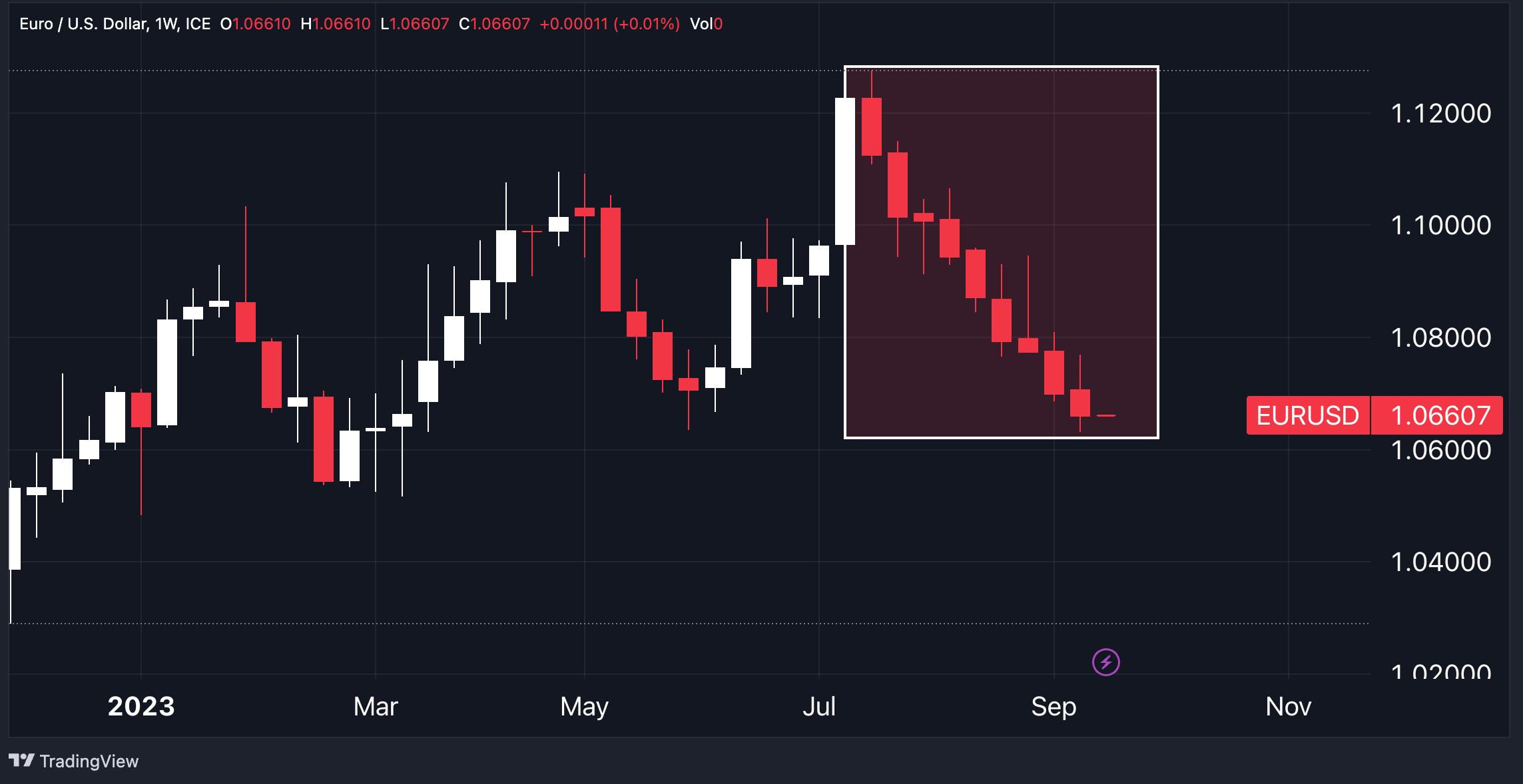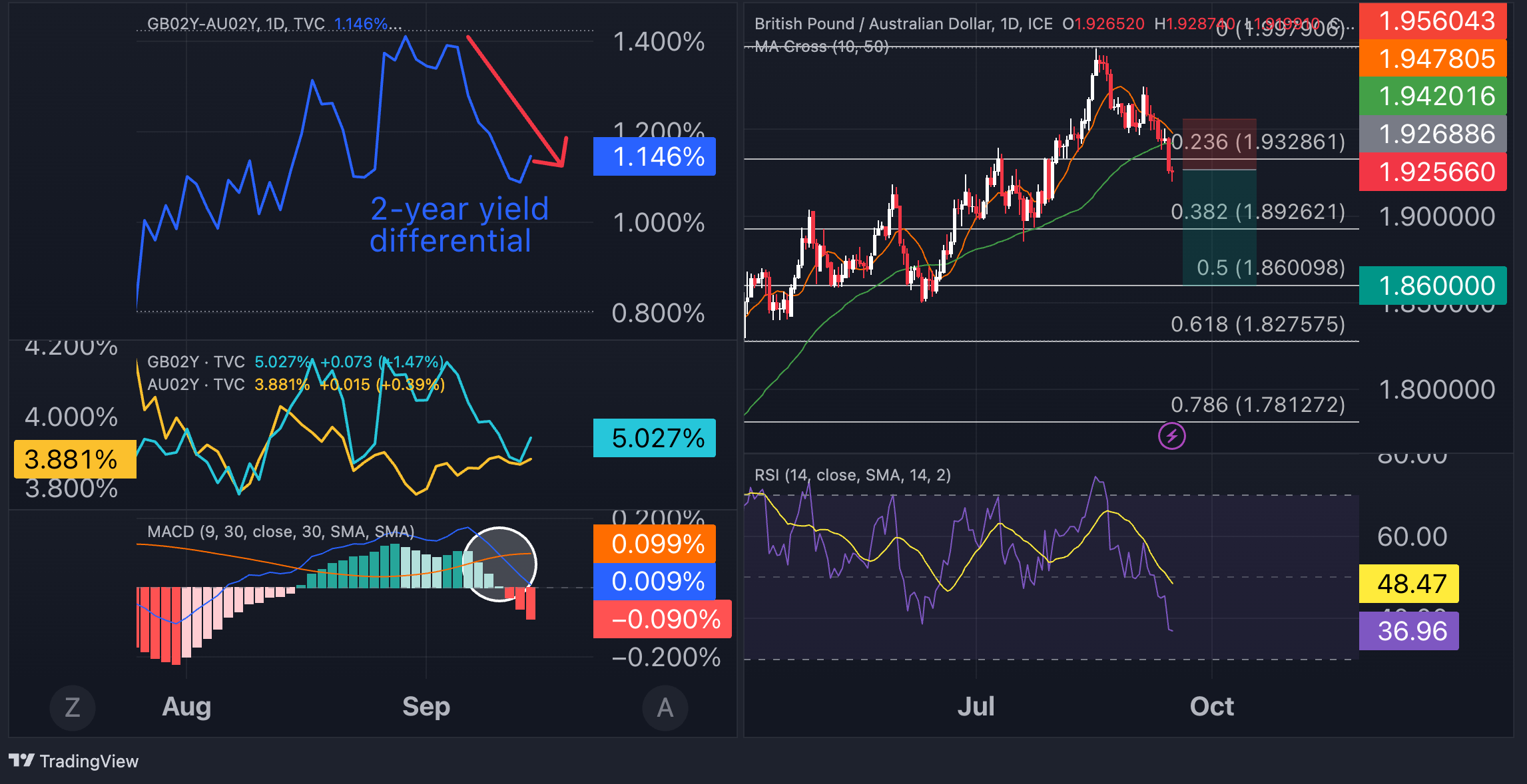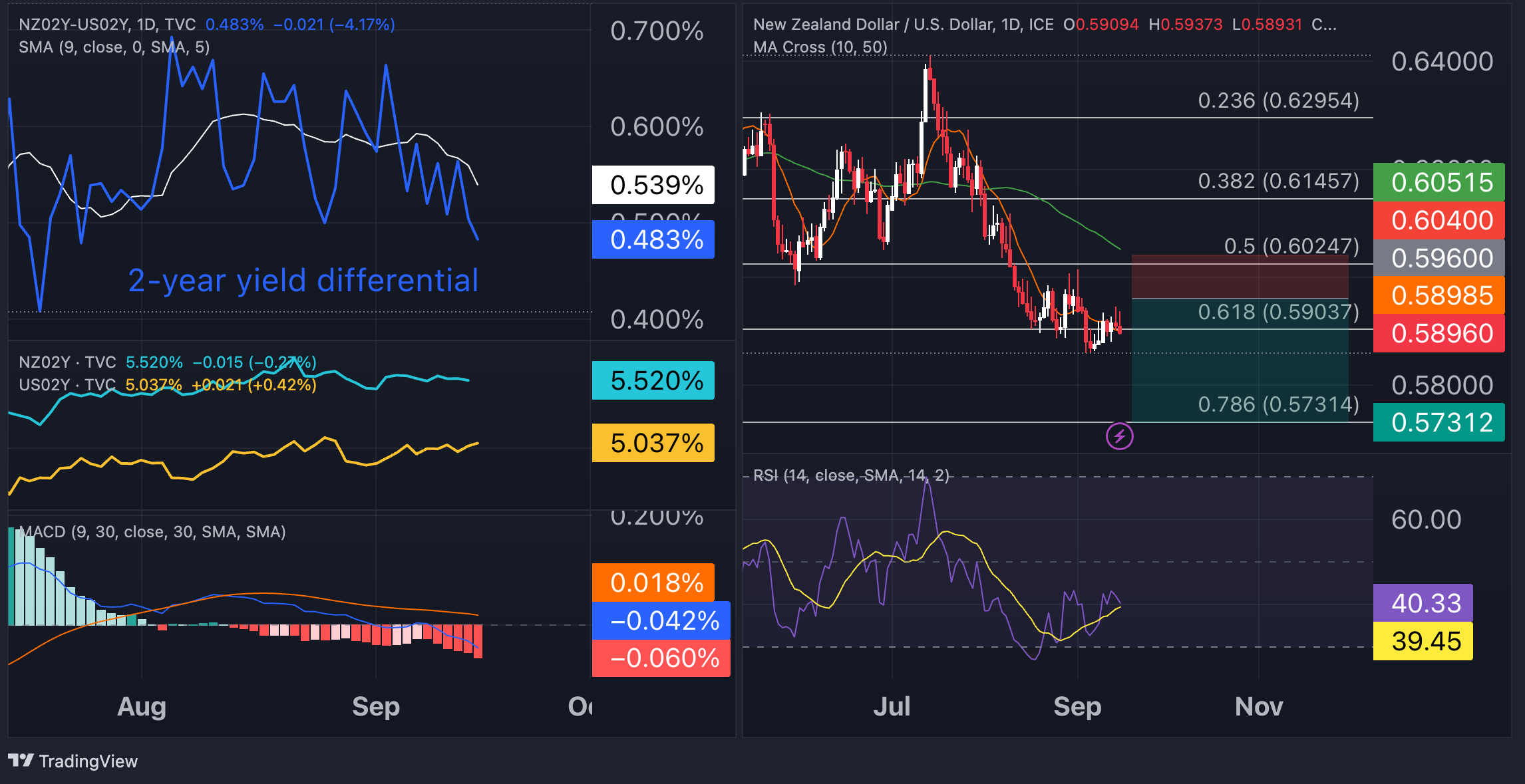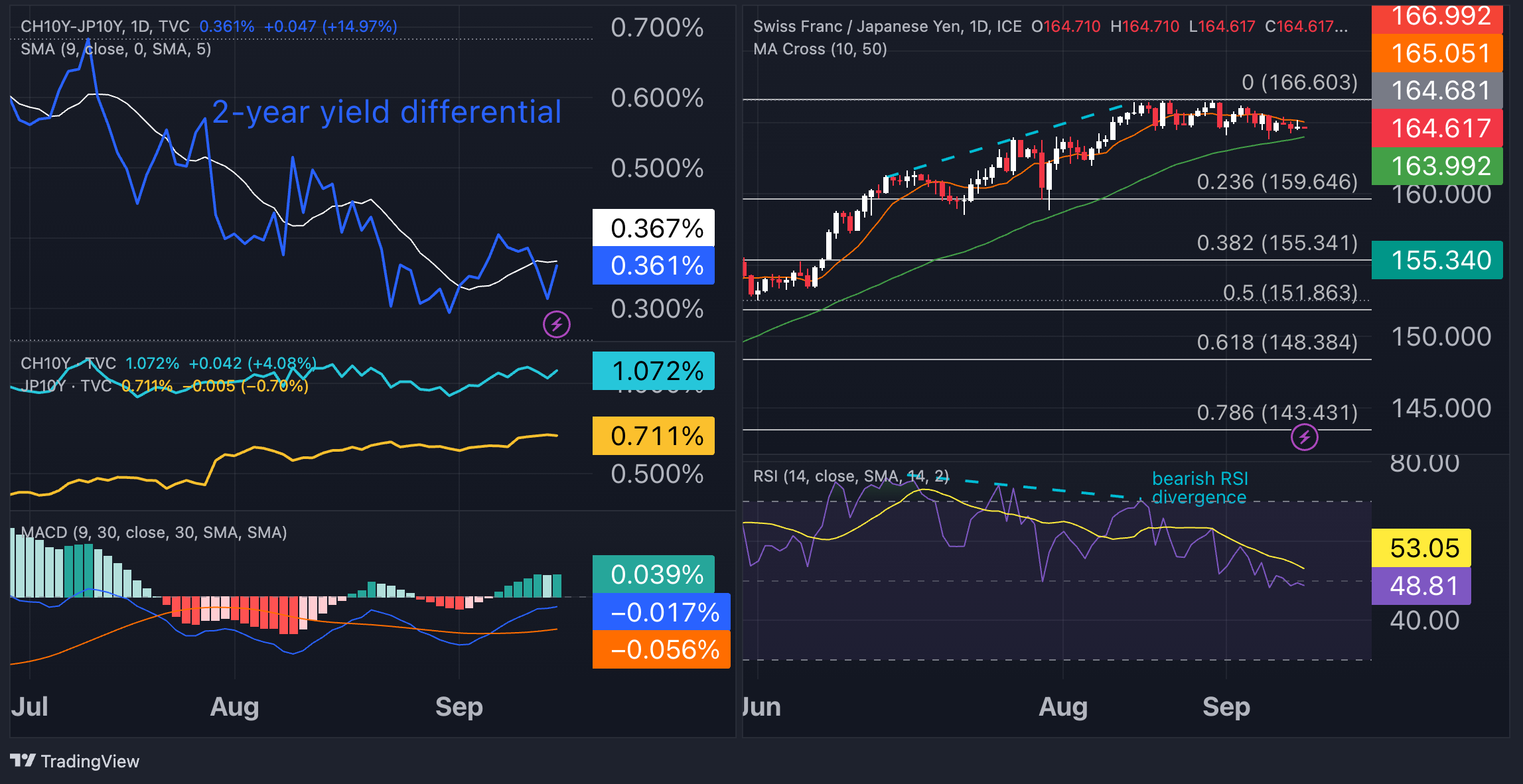For the ninth consecutive week, the U.S. dollar has shown remarkable strength, with the DXY index surging above 105, reaching its highest point since mid-March.
Forex Market Review: What Happened Last Week
For the ninth consecutive week, the U.S. dollar has shown remarkable strength, with the DXY index surging above 105, reaching its highest point since mid-March. This upward movement can be attributed to two main factors: higher-than-anticipated inflation figures for the U.S. in August and a “dovish hike” announced by the European Central Bank (ECB).
In August, U.S. consumer inflation exceeded expectations, reaching an annual rate of 3.7%, surpassing the anticipated 3.6%, and marking a robust 0.6% monthly increase.
Moreover, U.S. producer inflation outpaced market forecasts with a 0.7% monthly increase, surpassing the expected 0.4% uptick.
The ECB raised interest rates by 25 basis points, but their accompanying statement appeared more dovish than anticipated, suggesting that the current level of interest rates may be sufficient to control inflation and bring it back in line with their target.
The euro depreciated significantly in response, with the EUR/USD pair falling below 1.07, marking its lowest point since mid-March. This loss marked the ninth consecutive week of decline for the euro, making it the worst-performing streak since the currency's inception.
The commodity-linked Canadian dollar (CAD) and Australian dollar (AUD) were week’s the top performers, gaining 0.9% and 0.8%, respectively, against the U.S. dollar, aided by the surge in WTI prices to $90 per barrel, the highest level in over 10 months.
Surprisingly, the oil-rich Norwegian krone (NOK) weakened substantially, influenced by pessimistic outlook for the eurozone.
Despite renewed inflationary pressures throughout the week, the Japanese Yen (JPY) remained resilient, thanks to hawkish remarks from the Bank of Japan (BoJ) at the beginning of the week.
Looking ahead, the upcoming week will place the Federal Reserve Open Market Committee (FOMC) Meeting at the forefront of economic events, with the decision scheduled for Wednesday at 8:00 p.m. CET. Markets almost fully price in interest rates to stay on hold.
Additionally, Thursday will witness three major central banks making decisions on interest rates, namely the Bank of England (BoE), the Swiss National Bank (SNB), and the BoJ. Furthermore, the Norges Bank will also convene on Thursday.
Key Economic Events To Monitor This Week
United States:
- Fed interest rate decision (Wed.): 5.25%-5.5% prior, 5.25%-5.5% expected
- Fed Summary of Economic Projections (Wed.)
- Jerome Powell Press Conference (Wed.).
- S&P Global Manufacturing PMI (Fri.): 47.9 prior, 47.9 expected
- S&P Global Services PMI (Fri.): 50.5 prior, 50.3 expected
Euro Area:
- Inflation rate (Aug. final) (Tue.): 5.3% initial estimate
- ECB’s Lagarde speech (Thu.)
- S&P Global Manufacturing PMI (Fri.): 43.5 prior, 44 expected
- S&P Global Services PMI (Fri.): 47.9 prior, 47.5 expected
United Kingdom:
- BoE interest rate decision (Thu.): 5.25% prior, 5.5% expected
- UK inflation rate for August (Wed.): 6.8% y/y prior, 7.1% expected
Other Data To Follow:
- SNB interest rate decision (Thu.): 1.75% prior, 2% expected
- Japan core inflation rate (Thu.): 3.1% prior, 3% expected
- Bank of Japan interest rate decision (Thu.): -0.1% prior, -0.1% expected
- Canada inflation rate (Tue.): 3.3% prior, 3.8% consensus
- New Zealand GDP growth rate Q2 (Wed.): -0.1% q/q prior; 0.5% expected
- Norges Bank interest rate decision (Thu.): 4% prior, 4.25% expected.
Chart Of The Week: EUR/USD has recorded its ninth consecutive weekly decline, marking its longest losing streak in history

New Trades for The Week
Short GBP/AUD
- Entry: 1.9250
- Take profit: 1.8600
- Stop Loss: 1.9560
- Risk/Reward Ratio: 2.3

GBP/AUD Fundamental Analysis:
The Australian dollar is in the early stages of reversing its 2023 downtrend, mainly driven by two crucial factors: firstly, stimulus measures in China, and secondly, the rising prices of global commodities. This week, the RBA will release the minutes from its most recent meeting, during which it held interest rates steady but hinted at the possibility of future rate hikes. In the UK, the focal point is the BoE meeting scheduled for Thursday, with insight provided by Wednesday's inflation data. While a rise to 5.5% is anticipated, there is also a risk that the BoE may adopt a stance similar to that of the ECB, suggesting that the current interest rate level is sufficiently restrictive. The 2-year bond yield differential between the UK and Australia is trending downwards, with the MACD indicating a bearish crossover. This confirms the ongoing downtrend in the GBP/AUD pair and implies potential further declines.
GBP/AUD Technical Analysis:
The 10-day moving average is perilously approaching a downward cross with the 50-day moving average, signaling a potential reversal of the bullish trend that has characterized the pair since February 2023. The relative strength index (RSI) is pointing downward, indicating that bears are gaining control of the short-term trend. The Fibonacci retracement analysis, based on 2023 highs and lows, suggests that 1.8600 (50%) could be the next target for bears. A stop loss can be placed at 1.9560, just above last week's highs.
Order Short NZD/USD
- Entry: 0.5956
- Take Profit: 0.57313
- Stop Loss: 0.6032
- Risk/Reward Ratio: 3.00

NZD/USD Fundamental Analysis:
The Reserve Bank of New Zealand appears to have concluded its tightening cycle, after maintaining interest rates unchanged for the second consecutive time in August. Nevertheless, some support for the New Zealand dollar may come from external factors, as China is expected to announce its 1-year and 5-year loan prime rates on Tuesday. A potential rate cut could provide a boost to the Kiwi. However, this uptick may be short-lived, as the Federal Reserve could potentially adopt a more hawkish tone than anticipated on Wednesday. While keeping rates steady is widely expected, Powell might signal the need for further rate hikes, given the recent resurgence in inflation and economic strength. The 2-year yield differential between New Zealand and the United States is on a downward trend, with the MACD crossing below the zero line. This trend could continue to exert downward pressure on the NZD/USD pair for the time being.
NZD/USD Technical Analysis:
The pair has already experienced a significant downward move, so it may not be prudent to start a bearish position right away. Bears should exercise patience and look for more favorable entry points, such as around 0.5960, which served as a region of high liquidity between August and September. A potential profit-taking level could be set at 0.57 (corresponding to the 78.6% Fibonacci retracement level between the 2023 high and 2022 low), with a stop-loss placed just above the 50% Fibonacci level at 0.6040 (which also aligns with the 50-day moving average).
Short CHF/JPY:
- Entry: 164.61
- Take Profit: 155.34
- Stop Loss: 167.00
- Risk/Reward Ratio: 4.00

CHF/JPY Fundamental Analysis:
This week holds significant importance for the CHF/JPY pair as both respective central banks convene. The SNB is expected to implement a 25 basis point interest rate hike to 2%. However, this might mark the end of the tightening cycle, given the diminishing inflationary pressures and the deteriorating economic prospects in Europe. In August 2023, Switzerland witnessed a 0.8% year-on-year decline in producer and import prices, marking the fourth consecutive month of deflation, while consumer inflation (1.6%) came in at the lowest since January 2022. Conversely, although the BoJ is not anticipated to modify interest rates at this moment, it may signal its intention to do so in the near future. BoJ Governor Kazuo Ueda had already issued verbal warnings to the markets last week. The 10-year yield differential between Switzerland and Japan has been declining since August, suggesting that the recent uptrend in CHF/JPY may not align with fundamental factors.
CHF/JPY Technical Analysis:
From a technical standpoint, the pair likely reached its peak in August at 166.60, accompanied by a bearish RSI divergence. The onset of a downtrend is yet to occur, as the pair has exhibited more sideways movement since then.
Nevertheless, there are signs of a bearish momentum gathering strength as the 10-day moving average is approaching a potentially significant downward crossover with the 50-day moving average. If this trend continues, it could signal a notable reversal, possibly targeting a level around 155.34, which corresponds to the 38.2% Fibonacci retracement level of the 2023 high-to-low range. To manage risk, a stop-loss order could be placed just slightly above the highs reached in 2023.
Open trading ideas:
- Short GBP/JPY
- Opened on September 11th at 182.96
- Take Profit: 175.9
- Stop Loss: 185.6
- Profit & Loss: +0.1%
- Short EUR/JPY
- Opened on September 11th at 156.78
- Take Profit: 151.88
- Stop Loss: 158.5
- Profit & Loss: -0.4%
- Long USD/PLN:
- Opened on September 11th at 4.3058
- Take Profit: 4.6311
- Stop Loss: 4.1745
- Profit & Loss: +1.1%
- Short GBP/CHF
- Opened on September 4th at 1.1156
- Take Profit: 1.09
- Stop Loss: 1.1250
- Profit & Loss: +0.4%
- Short EUR/AUD
- Opened on September 4th at 1.6708
- Take Profit: 1.6200
- Stop Loss: 1.6900
- Profit & Loss: +1.1%
- Long USD/CHF
- Opened on August 28th at 0.8840
- Take Profit: 0.9250
- Stop Loss: 0.8680
- Profit & Loss: +1.4%
- Short GBP/CAD
- Opened on August 28th at 1.7115
- Take Profit: 1.6707
- Stop Loss: 1.7296
- Profit & Loss: +2.3%
- Long USD/CAD
- Opened on August 21st at 1.35
- Take Profit: 1.3860
- Stop Loss: 1.3350
- Profit & Loss: +0.0%
- Long CHF/NOK:
- Opened on August 21st at 12.06
- Take Profit: 12.47
- Stop Loss: 11.89
- Profit & Loss: +0.0%
- Short GBP/USD:
- Opened on August 14th at 1.2690
- Take Profit: 1.2310
- Stop Loss: 1.2850
- Profit & Loss: +2.3%
- Short NZD/JPY:
- Opened on August 14th at 86.70
- Take Profit: 83.50
- Stop Loss: 88.00
- Profit & Loss: +0.7%
- Short EUR/CAD:
- Opened on August 14 at 1.4730
- Take Profit: 1.4280
- Stop Loss: 1.49
- Profit & Loss: +2.3%
- Long U.S. Dollar Index (DXY):
- Opened on August 7th at 102.19
- Take Profit: 105.5
- Stop Loss: 100.90
- Profit & Loss: +3%
- Short NZD/CAD:
- Opened on July 24th at 0.8174
- Take Profit: 0.7975
- Stop Loss: 0.8263
- Profit & Loss: +2.4%




